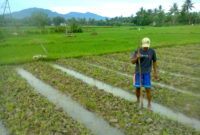Contour-furrow irrigation can save irrigation water, reduce erosion, and mean better crops on sloping fields. You waste little water by surface runoff or by over irrigation at the upper end of the furrows. In comparison with down -slope irrigation, water in contour furrows moves more slowly across the field and, therefore, does not erode or wash the soil. You get a more even distribution of water over the field, making good growing conditions for all of the plants. This pays off in better yields and in higher quality products. Irrigation water flowing down sloping fields is wasting our basic soil and water resources at a very serious rate. Contour-furrow irrigation can be a deciding factor in maintaining our agricultural production and our standard of living.

What Is Contour Furrow Irrigation Method?
With contour-furrow irrigation, water is carried across a sloping field rather than down the slope. The furrows have just enough grade to carry the irrigation streams. Head ditches or pipelines are run downhill, or slightly across the slope, to feed the individual furrows. When you use contour furrows to irrigate, it is much the same as if you moved fur- rows from a steep field to a flat bot- tom-land field.
Where Can Contour-Furrow Irrigation Be Used?
You can use the contour-furrow method of irrigation successfully on nearly all irrigable soils. Very light sandy soils and heavy adobe soils that crack badly when dry are exceptions. These soils should not be irrigated by this method. Very sandy soils are unstable, and the ridges between furrows are apt to break or wash out. This may let the water from one furrow flow into the next lower furrow, overloading that furrow and causing it to break over into the next lower furrow. Breaks like these, if they occur, are apt to continue all the way down the slope, causing heavy erosion dam- age. Cracks that occur in heavy adobe soils make channels for similar down-slope furrow breaks and field erosion. You can irrigate nearly all truck crops successfully by the contour- furrow method. Deep-furrowed row crops, such as potatoes, can be irrigated on slopes up to 8 percent on medium- and heavy -textured soils. On light soils, plantings should usually be limited to slopes less than 5 percent because of the danger of furrow breaks. For efficient irrigation of shallow-furrowed row crops, your contour plantings should be limited to lands having slopes of less than 3 percent. Permanent plantings such as citrus and deciduous fruits, cane herries, vineyards, and nut trees can also be irrigated successfully with contour furrows.
Where the furrows used in irrigating such crops need not be disturbed by cultivation, they can be used on land with slopes up to 20 percent. Under ideal conditions of soils and topography, land steeper than that has been success- fully irrigated. The furrows also carry off excess rainwater safely during the rainy season and thereby help to prevent erosion on your fields. A field with a uniform down slope and cross slope will have the highest number of through furrows and the smallest number of point rows (a crop row starting or ending part way across a field). It will also be the easiest field to irrigate. The more broken the topography, the more irregular will be the furrow and planting pattern. The topography must be uniform enough to permit a head ditch that can feed the entire area of furrows. It also must be regular enough to perm i i installing a waste ditch to carry off surplus irrigation water and rainwater. Irregular topography increases your labor cost- for irrigation. Fields should be smoothed as much as possible by land grading and floating before contour plantings are laid out. Shallow soils may limit the amount of smoothing that can be done.
